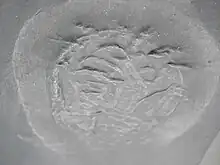| Weinbergina Temporal range: | |
|---|---|
 | |
| Fossil of Weinbergina opitzi, Naturmuseum Senckenberg | |
 | |
| Reconstruction | |
| Scientific classification | |
| Domain: | Eukaryota |
| Kingdom: | Animalia |
| Phylum: | Arthropoda |
| Subphylum: | Chelicerata |
| Clade: | Euchelicerata |
| Clade: | Prosomapoda |
| Genus: | †Weinbergina Richter & Richter, 1929 |
| Type species | |
| †Weinbergina opitzi Richter & Richter, 1929 | |
Weinbergina is a genus of synziphosurine,[1][2] a paraphyletic group of fossil chelicerate arthropods.[3][4] Fossils of the single and type species, W. opitzi, have been discovered in deposits of the Devonian period in the Hunsrück Slate, Germany.[2]
Morphology
Weinbergina is a relatively large synziphosurine, ranging about 7 cm to 10 cm in full body length.[2] The prosoma is covered by a semicircular carapace with blunt genal cornua (posterolateral corners).[2] There is possible evidence of lateral eyes located just below the ophthalmic ridges.[1] The opisthosoma is externally 10-segmented, expressed by tergites that possess blunt tergopleurae (lateral extension) and axial nodes. However, the opisthosoma is most likely 11-segmented in origin,[5] with the first segment being highly reduced (a synapomorphy of euchelicerates[3]) and possibly covered by the preceding carapace.[1][2] The last 3 segments form a narrow postabdomen and lacking lateral nodes.[1][2]

Compared to other synziphosurines with only scarce or no discovery of any evidence of appendages, the appendages of Weinbergina are exceptionally well-preserved in many described fossil materials.[1][2] Underneath the carapace are small chelicerae and pairs of well-developed, 8-segmented walking legs.[1][2] Each of the distal leg podomeres (segmental units) bore numerous spines-like projections, forming a snow-shoe-like termination.[1][2] The opisthosoma possess (possibly 6[5]) pairs of opercula with setose distal regions and possible evidence of book gills.[1][2]
Based on the interpretation of Stürmer & Bergström (1981) and Moore, Briggs & Bartels (2005), Weinbergina is unusual in having 6 pairs of walking legs instead of 5 or less like those of other euchelicerates.[1][2][5] The additional 6th leg pair was regarded to be originated from somite 7 (1st opisthosomal segment), thus homologous with the chilaria of horseshoe crab, metastoma of dekatriatan and 4th walking legs of sea spider.[2][3][5] However, the twelve-legged interpretation is not universally accepted - for example, Weinbergina was originally described as ten-legged like extant horseshoe crab;[2] Selden, Lamsdell & Qi (2015) noted that the structures previously identified as distal regions of walking legs may be in fact leg-like exopods like those of Offacolus and Dibasterium.[6][5]
Paleoecology
Weinbergina may have been a benthic animal with some degree of swimming ability, similar to modern horseshoe crabs.[1] However, the lack of doublure (ventral thickening run through the margin of carapace) suggests that Weinbergina is not adapted for a sediment-dwelling lifestyle as seen in the modern horseshoe crab.[1] The legs with snow-shoe-like terminations instead of chela (pincer) are also more adapted for walking on fine-grained surface instead of searching food items beneath the sediment.[1][2]
Classification
With Weinbergina as type genus, Weinbergina, Legrandella and Willwerathia were once united under the single family Weinberginidae,[2] an interpretation which is not recovered by later phylogenetic analysis.[6][7][8] After the revision of relationship between synziphosurines and other euchelicerates done by Lamsdell 2013,[3] Weinbergina was regarded as the basalmost member of Prosomapoda, a clade that included all euchelicerates except Offacolus and Dibasterium.[6][7][9][8][4][10]
References
- 1 2 3 4 5 6 7 8 9 10 11 12 Stürmer, Wilhelm; Bergström, Jan (1981). "Weinbergina, a xiphosuran arthropod from the devonian hunsrück slate" (PDF). Paläontologische Zeitschrift (in German). 55 (3): 237–255. doi:10.1007/BF02988142. ISSN 0031-0220. S2CID 128408596.
- 1 2 3 4 5 6 7 8 9 10 11 12 13 14 15 Moore, Rachel A.; Briggs, Derek E. G.; Bartels, Christoph (2005). "A new specimen of Weinbergina opitzi (Chelicerata: Xiphosura) from the Lower Devonian Hunsriick Slate, Germany". Paläontologische Zeitschrift. 79 (3): 399–408. doi:10.1007/BF02991931. ISSN 0031-0220. S2CID 84994966.
- 1 2 3 4 Lamsdell, James C. (2013). "Revised systematics of Palaeozoic 'horseshoe crabs' and the myth of monophyletic Xiphosura". Zoological Journal of the Linnean Society. 167 (1): 1–27. doi:10.1111/j.1096-3642.2012.00874.x. ISSN 0024-4082.
- 1 2 Bicknell, Russell D. C.; Pates, Stephen (2020). "Pictorial Atlas of Fossil and Extant Horseshoe Crabs, With Focus on Xiphosurida". Frontiers in Earth Science. 8: 98. Bibcode:2020FrEaS...8...98B. doi:10.3389/feart.2020.00098. ISSN 2296-6463. S2CID 220405124.
- 1 2 3 4 5 Dunlop, Jason A.; Lamsdell, James C. (2017-05-01). "Segmentation and tagmosis in Chelicerata". Arthropod Structure & Development. Evolution of Segmentation. 46 (3): 395–418. doi:10.1016/j.asd.2016.05.002. ISSN 1467-8039. PMID 27240897.
- 1 2 3 Selden, Paul A.; Lamsdell, James C.; Qi, Liu (2015). "An unusual euchelicerate linking horseshoe crabs and eurypterids, from the Lower Devonian (Lochkovian) of Yunnan, China". Zoologica Scripta. 44 (6): 645–652. doi:10.1111/zsc.12124. ISSN 0300-3256. S2CID 55264483.
- 1 2 Lamsdell, James C.; Briggs, Derek E. G.; Liu, Huaibao P.; Witzke, Brian J.; McKay, Robert M. (2015). "A new Ordovician arthropod from the Winneshiek Lagerstätte of Iowa (USA) reveals the ground plan of eurypterids and chasmataspidids". The Science of Nature. 102 (9–10): 63. Bibcode:2015SciNa.102...63L. doi:10.1007/s00114-015-1312-5. ISSN 0028-1042. PMID 26391849. S2CID 8153035.
- 1 2 Bicknell, Russell D. C.; Lustri, Lorenzo; Brougham, Tom (2019-12-01). "Revision of "Bellinurus" carteri (Chelicerata: Xiphosura) from the Late Devonian of Pennsylvania, USA". Comptes Rendus Palevol. 18 (8): 967–976. doi:10.1016/j.crpv.2019.08.002. ISSN 1631-0683.
- ↑ Lamsdell, James C. (2016). "Horseshoe crab phylogeny and independent colonizations of fresh water: ecological invasion as a driver for morphological innovation". Palaeontology. 59 (2): 181–194. doi:10.1111/pala.12220. ISSN 1475-4983. S2CID 85553811.
- ↑ Dunlop, J. A.; Penney, D.; Jekel, D. (2020). "A summary list of fossil spiders and their relatives" (PDF). World Spider Catalog. Natural History Museum Bern. pp. 1–296.